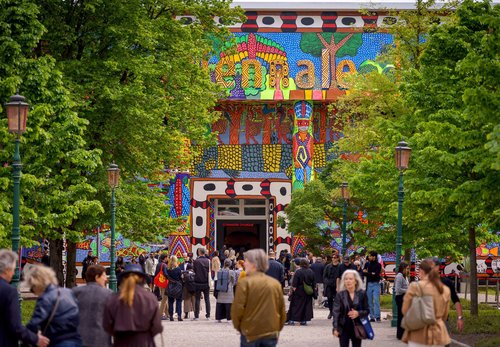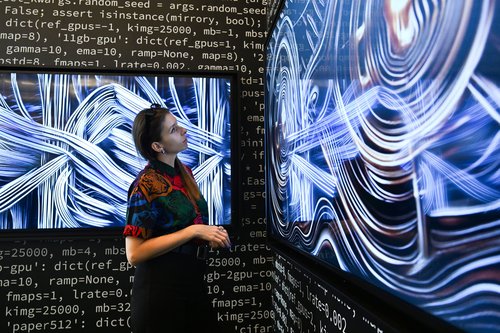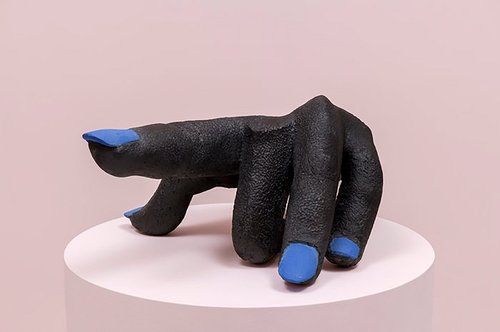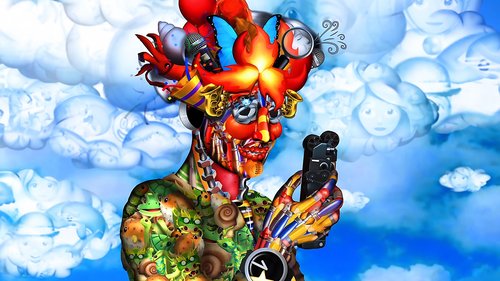Alexandra Dementieva. Re-Lightning, 2022. Photo by Edith Bunimovich. Courtesy of CYFEST
‘Vulnerability’ and ‘Digital Reform’ in Venice
With the AI boom upon us, we can engage playfully with new technologies as they evolve, inventing new ways of looking at the world, and at the same time dig deeper into our pre-industrial relationship with nature. Two Russian-backed art projects in Venice, ‘Vulnerability’ and ‘Digital Reform’ set aside more immediate geopolitical concerns in their search for humankind’s place in this new, fractured, high-tech world.
There was a tsunami of new users. Within just two months of ChatGPT app being launched by OpenAI back in November 2022, there were already over 100million users worldwide. It turns out that people everywhere love the idea of chatting with a bot, and within the next decade we shall all be using chatbots regularly. Created to imitate human conversation, chatbots have grown out of artificial intelligence, and from time to time I am haunted by visions of humankind dissolving into a space between the lines in a script written by chatbots (either they, or an evil force that has taken them over, will be writing the script). Could these new, generative, digital systems made user friendly for the masses, one day turn out to be the straw that breaks humanity’s back?
Cyland and TAEX are two art initiatives founded by female Russian entrepreneurs both working in the field of new media and looking closely at developments around AI as well as its impact on our lives. ‘Vulnerability’, Cyfest 15’s latest exhibition opened in Venice during the Biennale last month. Back in Russia in 2007, inspired by E.A.T. (the lab Experiments in Art and Technology) Anna Frants and Marina Koldobskaya set up Cyfest an interdisciplinary media art festival in St Petersburg focussed initially on cybernetics to bring together art and technology, and since then it has evolved into a nomadic and far broader new media festival. Cybernetics, a way of looking at the world through systems whether biological, social or physical is a direct precursor of AI and self-generation, and chatbot is a spiritual heir. Cyland, the organisation behind Cyfest, has been researching cybernetics for nearly two decades.
We should not worry too much about the future, say the curators, Silvia Burini and Elena Gubanova in their introduction to the catalogue for the exhibition, as many of us will be up to the challenge of adapting to the technological changes ahead. They point to a controversial yet popular notion put forward a decade ago by Lebanese American businessman and writer Nassim Nicholas Taleb which he called ‘Antifragility’. Referring either to individuals or human societies in general, if we are fragile, problems and chance events can destroy us, but if we are what he calls ‘antifragile’, problems will make us stronger and better. The key is that we adapt and change as we pass through challenges, which otherwise might destroy us.
In their text, Burini and Gubanova seem to be suggesting that we are closer to the future than we think. No longer in the realm of sci-fi, we already live in a ‘posthuman age’, they write that Freudian “human anatomy is no longer our destiny, but we measure ourselves now between two poles, Bio and Cyber”. It seems that when we reach deeply inside ourselves to try to find our sense of identity, it will no longer be within the limits of our own individual physical bodies, but part of a larger field in which we understand ourselves also in relation to cyber beings. If that does not repel you, a call of encouragement to positive engagement threads through this show, where nature is the real protagonist with whom we must engage if we are to survive.
Cyfest 15 is housed in vast redbrick building on Giudecca, the recently whitewashed exhibition space upstairs with an airy cathedral-like vaulted ceiling, I arrive with rain and wind lashing the roof on a predictably unstable April evening. The exhibition space is dominated by two large scale installations. The first, ‘Sensorial Skins’, by Belgian born artist AnneMarie Maes (b. 1955), is an arrangement of bacterial grown skins created over the past six years which are hanging like banners from the ceiling. Maes, who I meet there, is fascinated by the complex structures found in nature, her enthusiasm is infectious, and I find myself marvelling at the mysterious processes at work that create these skins, where the accent is on how natural forces share agency with the artist. Appealing to the senses, they are tactile objects with a peculiar smell and light shines through each one in different ways, some are more transparent, natural irregularities become interesting as they draw you in.
Maes’ bare and honest bacterial skins hang opposite a tall sliver of seven 40" digital screens assembled one above the other in a vertical line which reaches the apex of the vault. This video installation ‘Energy’ (2016) is by Italian artist Fabrizio Plessi (b. 1940), a pioneer of video art who spent the first decade of the century as professor of Humanization of Technologies and Electronic Sceneographies at the Kunsthochschule in Cologne. It depicts forks of lightening which, shown simultaneously across several screens creating at times one simultaneous strike, is an invitation for us to meditate on elemental energy in nature, its mysterious ways and power. Unlike the bacterial skins, this is nature filtered at arm’s length, there are cultural references like Andy Warhol’s multi-image screen prints and of Yves Klein in Plessi’s indigo sky. We experience this lightening through the blunt filter of human culture and technology.
These two installations vie for attention with one more large-scale work by ‘Where Dogs Run’ a Russian art collective formed in 2000 by a group of artists living and working in Ekaterinburg, a city which today has a strong, grassroots contemporary art scene. A woman sits knitting in a chair, surrounded by a sea of brightly coloured knitted wool shapes loosely forming a kind of scroll. The knitting pattern is based on the Mandelbrot Set, a mathematical formula which creates a distinctive visual form, a bit like two hearts on their sides with scrolls, discovered in the mid 1980s (as a kid I remember this pixelated form being created on the screen of my old home computer). Some numbers you plug into the formula create it and others do not, and in the decades since it was discovered, its mysteries have continued to haunt some of the world’s greatest mathematicians. The idea of this slow, repetitive process of knitting the Mandelbrot set, manifesting itself in a funky snail of brightly coloured, knitted wool is a reminder of the vagaries of human civilization in the face of mysterious natural and physical processes. In the end, there is also something innately human and comfortable about the simple act of knitting.
Elsewhere, hanging in a corner are three printed pictorial works called ‘Re-pressions’ by Armenian artist Samvel Baghdasaryan (1956–2017) made in the mid 1990s. These three panels which form a triptych, look like old, discarded sheets of rusty metal. Each panel has a series of circles pressed into it forming an abstract image. In the artist’s personal mythology, circles acquired different meanings according to the socio-political environment in which he made them. During the Soviet times, as a collector of Soviet posters, the artist would mark circles between propagandistic texts, in order to subvert their meaning. Later, after perestroika, making these marks became perhaps a way of counting or tallying change without losing a connection with the past. They are today, taken out of context, tactile objects which have a real presence.
Museums and galleries today need to keep up with the times, and on some level we all need to reach out and experiment with new technologies, an approach favoured by TAEX. In their show ‘Digital Reform’ at the Scoletta dell’Arte, an 18th century educational college where artisans once learnt how to make threads and gold leaf, in an intentional parallel over the centuries, the emphasis here is on education and learning. TAEX founder (and co-founder of Art Focus Now) Inna Bazhenova was born in Nizhny Novgorod, graduating as a mathematician after which she worked as an aeronautical engineer until she co-founded what became a highly successful business repurposing aero industrial technology in the early 1990s. New technologies have always interested her, and she has been an early and tireless supporter of crypto art. The curator of ‘Digital Reform’, Dr Antonio Geusa takes a playful, broad-brush approach, bringing together primarily interactive and generative digital contemporary artworks by established and new artists in the field, such as Shu Lea Cheang (b. 1954) and Mathieu Le Sourd, with old masters and avant-garde drawings, which in their own day represented new visual systems, like Kazimir Malevich’s pioneering suprematism - the central staircase in the Scoletta is hung with several works on paper by the artist. The concept of comparing the creation and exploration of new systems in art across different eras with a focus on our own and without the perspective of hindsight is a bold move, executed with a light and humorous touch.
Our understanding of AI today already takes its future potential as a given. Despite the mass uptick, chatbots are in an early stage of development, ChatGPT often gets simple questions wrong to great comic effect. At ‘Digital Reform’, visitors were handed a deck of cards with multiple choice questions about art history with the answers on the back of the card where both the questions and the answers had been created by AI. Looking at the cards, most of the time AI got the answer to its own questions spectacularly wrong but even some of the questions themselves lack sophistication: ‘The Design of Tatlin’s Tower, an unbuilt monument, is associated with which Russian Constructivist artist?






















